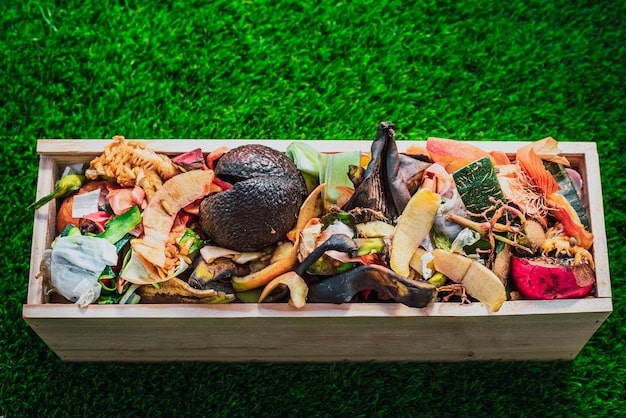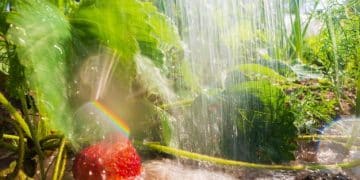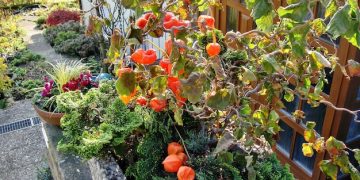Sustainable Gardening: Grow Food, Reduce Your Carbon Footprint

Sustainable gardening involves eco-friendly practices that reduce your carbon footprint by growing your own food, conserving water, minimizing waste, and avoiding harmful chemicals, thus promoting a healthier environment and a more sustainable lifestyle.
Are you looking to reduce your environmental impact while enjoying fresh, homegrown produce? **Sustainable gardening: Grow Your Own Food and Reduce Your Carbon Footprint** offers a powerful solution, combining the joys of gardening with eco-conscious practices.
What is Sustainable Gardening?
Sustainable gardening is more than just planting seeds; it’s about creating a garden ecosystem that works in harmony with nature. It’s about making choices that benefit the environment, from conserving water to reducing waste.
By adopting sustainable practices, you can minimize your carbon footprint and contribute to a healthier planet. Let’s delve deeper into the key aspects of sustainable gardening.
The Core Principles of Sustainable Gardening
At its heart, sustainable gardening is guided by a few fundamental principles, all aimed at reducing environmental impact and promoting biodiversity.
Understanding these principles will help you make informed decisions for your garden.
- Conserving Water: Efficient irrigation and drought-tolerant plants.
- Minimizing Waste: Composting and recycling organic materials.
- Avoiding Chemicals: Using natural pest control and fertilizers.
- Promoting Biodiversity: Planting a variety of species to support local ecosystems.

These principles are interconnected, creating a holistic approach to gardening that benefits both you and the environment. Embrace them, and you’ll be well on your way to creating a truly sustainable garden.
Benefits of Sustainable Gardening
Beyond the environmental benefits, turning to sustainable gardening brings a host of advantages for you, your family, and your community.
From healthier food to cost savings, the rewards are abundant.
Healthier Food
Growing your own food allows you to control what goes into it. No harsh pesticides, herbicides or chemicals harming the soil or your plants – only clean, organic goodness.
This results in more nutritious and safer food choices for you and your family.
Reduced Carbon Footprint
One of the most significant advantages of sustainable gardening is its potential to reduce your carbon footprint. By growing your own food, you decrease your reliance on the industrial food system, which is a major contributor to greenhouse gas emissions.
Less transportation of food over long distances also translates to lower emissions, further minimizing your environmental impact.
Cost Savings
While there may be some initial investment in setting up a sustainable garden, you’ll quickly find that you’re saving money by buying fewer groceries, especially produce.
Additionally, certain methods will decrease your water bill, and reduce the need for expensive fertilizers and pesticides.
Ultimately, this makes your garden a cost-effective and rewarding endeavor for years to come.
How to Start a Sustainable Garden
Starting a sustainable garden can seem daunting, but it’s easier than you might think. With a few simple steps, you can create a thriving and eco-friendly space.
Start small, learn as you go, and enjoy the process.
Choosing the Right Location
The first step in starting a sustainable garden is selecting the right location. Consider factors like sunlight, soil quality and water access.
Most vegetables need at least six hours of sunlight per day.
Assess your soil to determine if it needs amendments like compost or other organic matter. Finally, ensure you have easy access to water, whether from a rain barrel, a well or a hose.
Soil Health and Composting
Healthy soil is the foundation of a thriving sustainable garden. Focus on building soil health through composting and avoiding synthetic fertilizers.
Composting is a simple way to recycle kitchen scraps and yard waste into nutrient-rich soil amendment.
You can also improve soil health by using cover crops, which add organic matter and prevent erosion. By focusing on soil health, you’ll create a resilient and productive garden ecosystem.
Water Conservation Techniques
Conserving water is a key component of sustainable gardening. Implement efficient irrigation techniques and choose drought-tolerant plants to minimize water usage.
Consider using drip irrigation or soaker hoses, which deliver water directly to plant roots.
This reduces water waste and prevents foliar diseases. Mulching around plants also helps retain moisture in the soil. Selecting native or drought-tolerant plants that are well-suited to your local climate can greatly reduce your water needs.

Choosing the Right Plants
Selecting the right plants for your sustainable garden is crucial for its success. Focus on native species, companion planting, and plants that attract pollinators.
Consider the needs of these plants as well as the area in which you are planting them.
Native Plants
Native plants are adapted to your local climate and soil conditions. They require less water, fertilizer, and pest control than non-native species.
They also provide habitat and food for native wildlife, promoting biodiversity in your garden. Researching native plants in your area is crucial for creating a sustainable and thriving garden ecosystem.
Companion Planting
Companion planting involves growing different plants together that benefit each other. Some plants repel pests, others attract pollinators, while others improve soil conditions.
For example, basil repels pests from tomatoes, while beans fix nitrogen in the soil, benefiting nearby plants. Understanding which plants thrive together can enhance the health and productivity of your garden.
Attracting Pollinators
Pollinators play a vital role in plant reproduction. Attract them to your garden by planting flowers that provide nectar and pollen.
Consider plants like lavender, sunflowers, and bee balm. Avoid using pesticides that can harm pollinators. Creating a pollinator-friendly garden can boost your yields and support local bee populations.
Pest and Weed Management
Managing pests and weeds sustainably is essential for maintaining a healthy garden without harming the environment. Focus on natural pest control methods and preventative measures.
Avoid synthetic pesticides and herbicides, which can harm beneficial insects, wildlife and your health.
Natural Pest Control
There are many natural ways to control pests in your garden. Introduce beneficial insects like ladybugs and lacewings, which prey on aphids and other pests.
Use organic pesticides like neem oil or insecticidal soap. Create physical barriers like row covers to protect plants from pests. Regularly inspect your plants and remove any pests by hand. By utilizing these natural methods, you can keep your garden healthy without resorting to harmful chemicals.
Weed Management
Weeds compete with your plants for nutrients and water. Prevent weeds by mulching around plants, which blocks sunlight and inhibits weed growth.
Hand-pull weeds regularly, especially before they go to seed. Use tools such as hoes and cultivators to remove weeds between rows. Avoid using herbicides, which can harm beneficial insects and soil organisms.
Reducing Your Carbon Footprint Through Gardening
One of the most compelling reasons to embrace sustainable gardening is its potential to reduce your carbon footprint. By growing your own food, you can minimize your reliance on industrial agriculture, which relies heavily on fossil fuels.
From transportation to packaging, the industrial food system contributes significantly to greenhouse gas emissions.
Homegrown vs. Store-Bought
Consider the journey that store-bought produce takes to reach your plate. It’s grown on large-scale farms, often treated with synthetic fertilizers and pesticides, harvested by machines, and transported long distances.
All of these activities require energy and generate emissions. In contrast, homegrown produce travels only a few steps from your garden to your table, reducing transportation emissions.
Composting and Waste Reduction
Composting is another way sustainable gardening reduces your carbon footprint. By composting kitchen scraps and yard waste, you divert organic material from landfills, where it decomposes anaerobically and releases methane, a potent greenhouse gas.
Compost adds organic matter to your soil, improving its structure and fertility. This reduces the need for synthetic fertilizers, which are produced using fossil fuels. Composting closes the loop, transforming waste into a valuable resource for your garden.
Sustainable Consumption
Sustainable gardening promotes sustainable consumption habits. When you grow your own food, you become more aware of the resources required to produce it. This awareness can lead to more mindful consumption choices.
You may be more likely to reduce food waste, eat seasonally, and support local farmers. These changes can have a significant impact on reducing your carbon footprint and promoting a more sustainable lifestyle.
| Key Point | Brief Description |
|---|---|
| 🌱 Soil Health | Rich soil through composting boosts plant growth and reduces fertilizer use. |
| 💧 Water Conservation | Efficient irrigation and drought-resistant plants minimize water waste. |
| 🌿 Natural Pest Control | Using beneficial insects and organic methods to protect plants. |
| 🌎 Carbon Footprint | Growing food locally reduces transportation emissions and supports sustainability. |
FAQ
Prioritizing soil health through composting and avoiding synthetic fertilizers is key to sustainable gardening. Healthy soil supports plant growth and reduces the need for external inputs.
Use drip irrigation or soaker hoses to deliver water directly to plant roots. Mulch around plants to retain moisture and choose drought-tolerant species suited to your local climate.
Introduce beneficial insects like ladybugs and lacewings. Use organic pesticides such as neem oil, or create physical barriers using row covers to shield your plants from pests naturally.
Growing your own food reduces transportation emissions associated with industrial agriculture. Composting also diverts organic waste from landfills, minimizing methane release, a potent greenhouse gas.
Companion planting enhances plant health and productivity. Certain plants repel pests, attract pollinators, and improve soil structure, creating a balanced and thriving garden ecosystem.
Conclusion
Embarking on a journey into **sustainable gardening** offers a harmonious blend of environmental responsibility and personal fulfillment. By adopting eco-friendly practices, you’re not only reducing your carbon footprint but also cultivating a healthier lifestyle filled with fresh, homegrown produce. Whether it’s through composting, water conservation, or natural pest control, every step you take contributes to a greener, more sustainable world.





